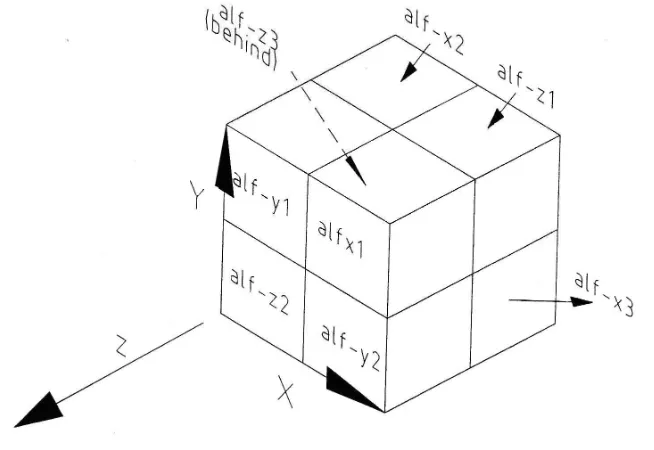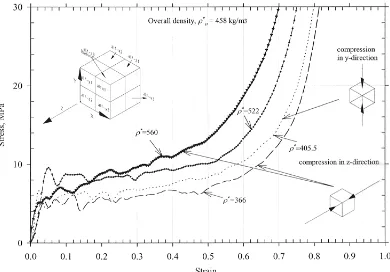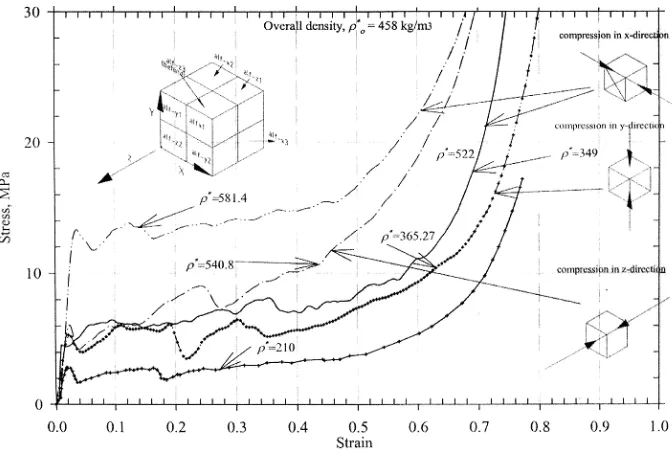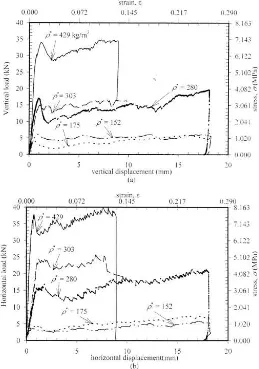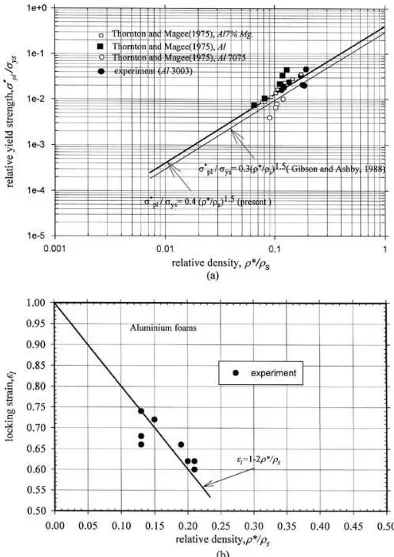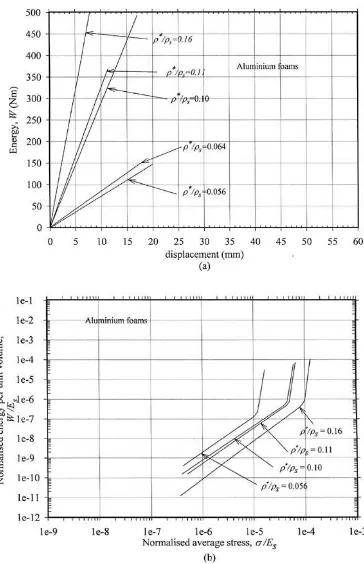www.science.cmu.ac.th/journal-science/josci.html Contributed Paper
The Response of Aluminium Foams Under
Quasi-Static Loading
Mohamad R. Said [a] and Chee-Fai Tan*[b]
[a] Faculty of Mechanical Engineering, Universiti Teknikal Malaysia Melaka, Locked bag 1200, Ayer Keroh, 75450 Melaka, Malaysia.
[b] Designed Intelligence Group, Department of Industrial Design, Technical University Eindhoven, Den Dolech 2, 5600MB Eindhoven, the Netherlands.
*Author for correspondence; e-mail: [email protected]
Received: 25 March 2008 Accepted: 3 June 2008.
ABSTRACT
Aluminium foams are now being considered for use in lightweight structural sandwich panels such as aircraft body and in energy absorption systems for protection from impacts. In both cases, they may be subject to uniaxial and as well as biaxial loadings. In this study, the uniaxial loading at a rate of 5 mm/min was performed to find the crushing characteristics and their directional dependency. Eight specimens were used in uniaxial compression. The load responses were recorded and compared with the biaxial loading. Biaxial tests were conducted in a custom testing facility between rigid platens, which can be moved independently in two principles direction at the same speed. Five specimens in biaxial loading in various densities were used. Considerable enhancement in collapse loads and lead to higher energy absorption was seen in biaxially loaded metallic foams in comparison with uniaxial loading. The refined empirical relationship for uniaxial loading was also developed and was satisfactory well with the experiment.
Keywords: aluminium forms, compression, quasi-static loading.
1. INTRODUCTION
In recent years, renewed interest has been obser ved in the application of cellular materials such as aluminium honeycombs and foams as materials for energy absorption devices and lightweight structural sandwich panels. Beside a high specific energy, it provides the stable deformation behaviour.
Much effort has been devoted to the study of mechanical properties of foams. Based on the pioneering work of Maiti et al. [1], and Gibson and Ashby [2] provided a
semi-empirical formula for plastic collapse stress, of foam, using an isotropic behaviour, as
(1)
where, is the ratio of density of cellular to density of cell wall material. Collapse is initiated in a weak row of cells and progresses
increase in the slope of load-displacement curve was seen when the crushed zones have covered all the initial volume of a cell wall material. The strain at transition from the cell wall collapse process at a constant stress to solid phase compression of the cell wall material is called a locking strain, el. The locking strain was also seen by Maiti et al. [1], who introduced an empirical constant, a, which is determined experi-mentally, as in equation 2. (2) Foams with closed cells structure are more difficult to analyse, as they contain a thickness variation from cell edges to cell faces. There are also entrapped gases in these cells and the flow of these gases during compression will have to be considered.
Santosa and Wierzbicki [3] have studied the behaviour of closed-cell metallic foams. They compared the published experimental results on aluminium foams under
compression with their numerical analysis. They used finite element code by modelling the foams as a truncated cube to simulate the defor mation mechanism. They also developed a semi-empirical relationship for the crushing stress given by,
(3)
which is as good as , giving an error
of < 2% at . They used a constant flow stress of so = 139.2 MPa for the aluminium material and obtained a crushing stress from their model that agreed well with experiment.
However, no work has been done on aluminium foam subject to biaxial loading. This paper describes the experimental work on uniaxial and biaxial loading with a particular interest in energy absorption during quasi-static
Figure 2. Stress-strain of characteristics aluminium foams of different density under quasi-compression. The energy absorbed was
found by calculating the area under load-compression curve.
2. EXPERIMENTAL PROCEDURE
2.1. Uniaxial Compression of Aluminium Foams
A limited number of aluminium foam specimens of different densities were tested under quasi-static axial loading condition. To find the uniaxial crushing characteristics and their directional dependency, simple compression tests in different directions were carried out under quasi-static condition at crosshead speed of 5 mm/min. Eight smaller specimens were cut from an original cubic block (of 70 mm side) of aluminium foam with a specified overall density, ρo* of 458 kg/m3 as shown in Figure 1.
Figure 2 and figure 3 show the nominal
Figure 3. Stress-strain of characteristics aluminium foams of different density under quasi-static uniaxial compression. The orientation and the direction of compression are also indicated. cur ve up to a displacement consistent with locking strain is shown in column 8 of Table 1.
2.2 Biaxial Compression of Foams
Biaxial crushing tests were conducted in a purpose built rig as shown in Figure 4. The frictional behaviour of the rig is also examined. Twelve aluminium honeycomb specimens
Table 1. A summary of result of aluminium foams under biaxial compression.
Density Collapse load (kN) Mean load, Fm (kN) Energy absorption, W Total energy,
ρρρρρ* Fc up to10mm up to 10mm displacement W absorbed
(kg/m3) displacement (Nm) (Nm)
vertical horizontal vertical horizontal vertical horizontal
direction direction direction direction compression compression
152 4 3.5 3.1 3.2 31 32 63
175 6 4.3 4.9 4.2 49 42 91
280 17 15.6 12.5 14.1 125 141 266
303 15 24 14 21 142 202 344
429 34 38 30 35 241 310 551
Figure 5. Graphs of load-displacement curves (or stress-strain) for aluminium foam specimens (70 mm cubes) with various densities during biaxial compression (a) Vertical load against
Figure 4. The arrangement of biaxial rig, showing the components.
RDP crosshead
Solid circular column
Left cylinder
Specimen
Loading frame
Linear bearing guideway
LVDT 1
Right cylinder
Figure 6.(a) Normalised yield strength versus normalized density for aluminium foams under quasi-static uniaxial compression.
each of the same density and five aluminium foam specimens of different densities were compressed biaxially. Five aluminium foam specimens of various overall densities, ρo*
were compressed under quasi-static biaxial loading condition. The densities of foams were varied from 175 kg/m3 to 429 kg/m3.
Figure 5 (a) and figure 5 (b) show the vertical and horizontal load-displacement curves (or stress-strain curves) under biaxial loading. As in the case of simple compression, the curves show a linear-elastic region followed by elastic-plastic zone before initial collapse. These are seen in all densities. A sudden drop in load (just after the peak load) also appears in the curves in all cases. This may indicate localised deformation. Table 1 shows the summary of results of aluminium foams under biaxial test. The total energy absorbed is noted in the fifth column.
3. DISCUSSION
3.1. Uniaxial Compression of Aluminium Foams
The normalised yield stress and the normalised density for aluminium foams is plotted in Figure 5a and is compared with the semi-empirical relationship developed by Gibson and Ashby [2]. Experimental results from the present investigation as well as those due to Thornton and Magee [5] were used in this plot. The empirical relationship is that for open-cell foam. The present experimental data is close to Gibson and Ashby’s empirical relationship shown on the graph. However, if the previous work done by Thornton and Magee [6] is included, this relationship can be refined to,
(4)
This refined relationship was satisfactory well in experiment as shown in Figure 3a if cell wall material density, ρs is taken as 2730 kg/ m3 and yield stress, σ
ys as 290 MPa from the manufacturer’s data. For example, the predicted crushing stress, σ∗pl for foam density,
ρ∗of 406 kg/m3 was 6.7 MPa, which was
less than 3% deviation with experiment. It is worth noting that Gibson and Ashby’s expression based on the polymeric foams while the data in Figure 6a is for aluminium (metallic) foams. The locking strain against relative density is plotted in Figure 6b. The best fitting straight line is given by the following equation.
(5)
It is interesting to note that this relationship (equation 5) is identical to that of Maiti et al. [1], which is based on the data for balsa wood.
3.2. Biaxial Compression of Aluminium Foams
Figure 7.Experimental energy-absorption curve for foams curves under biaxial loading. (a) Energy-absorbed against displacement and
4. CONCLUSIONS
In this experiment, the crushing characteristics of aluminium foams and their directional dependency were determined. It was noticed that a considerable enhancement in collapse loads in biaxially loaded metallic foams in comparison with uniaxial loading. This led to higher energy absorption. The refined empirical relationship for uniaxial loading was also developed and was satisfactory well with the experiment. REFERENCES
[1] Maiti S.K., Gibson L.J. and Ashby M.F., Deformation and energy absorption diagrams for cellular solids, Acta. Metall., 1984; 32(11): 1963-1975.
[2] Gibson L.J. and Ashby M.F., Cellular Solids: Structures and Properties, 2nd Edn.
Cambridge University Press, UK, 1998. [3] Santosa S. and Wierzbicki T., On the modelling of crush behaviour of a closed-cell aluminium foam structure, J. Mech. Phys.Solids, 1998; 46(4):645-669. [4] Said M.R., Energy absorption in certain
cellular structures under uniaxial and biaxial loading, PhD Thesis, UMIST, UK, 2000. [5] Thornton P.H. and Magee C.L., The
deformation of aluminum foams, Met. Trans. A, 1975a; 6A: 1253-1263.
